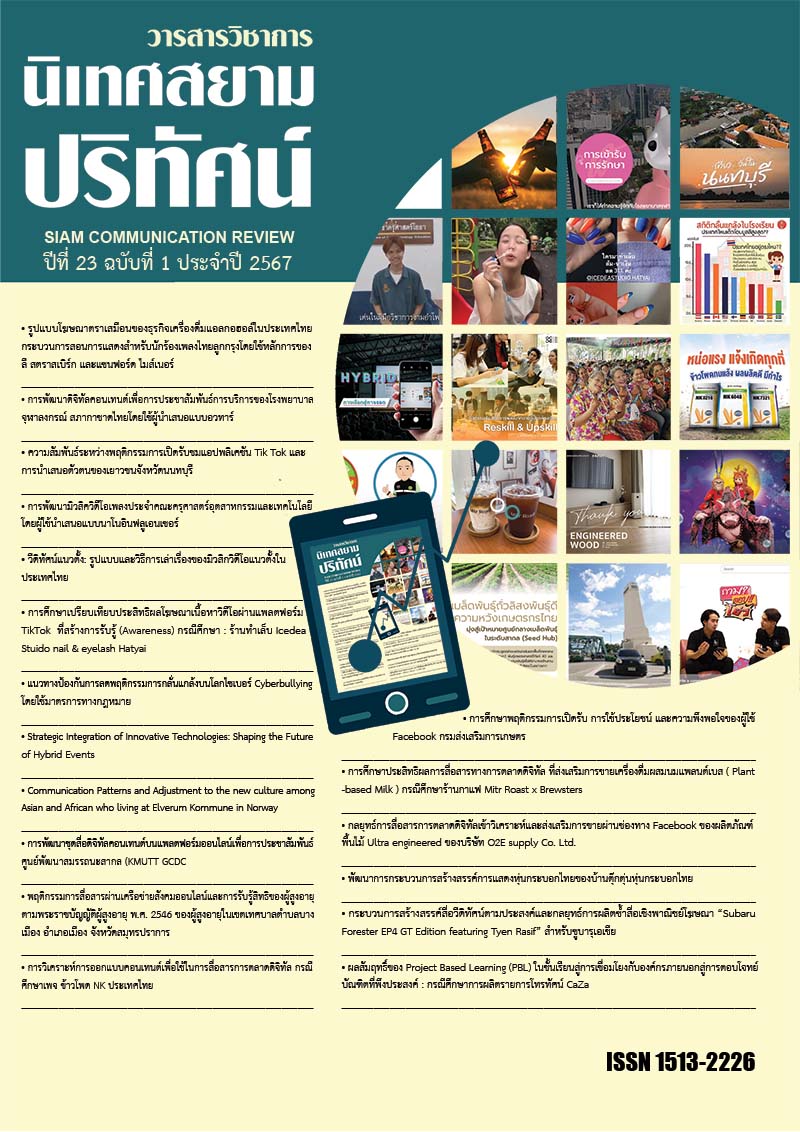The achievement of classroom’s Project Based Learning (PBL) associates with outside organization to meet the requirement of desired graduate: A case study of CaZa TV Program Production
Main Article Content
Abstract
The achievement of classroom’s Project Based Learning (PBL) associates with outside organization to meet the requirement of desired graduate: A case study of CaZa TV Program Production, is the academic article that aims to summarize the lesson learned from the student TV program production. The project arose from the collaboration of Faculty of Communication Arts, Kasem Bundit University, and Thai Health Promotion Foundation (ThaiHealth). TV programs production were created to promote social well-being, physical and mental health capability, and health literacy, which are fundamental factors of peaceful society. Under the concept of entertainment TV program, the information on dangerous things and addictive substance, which are risk factors for teenager, were joyfully presented together with pointing out how dangers and disadvantages they are. The program also recommended behavior modification and other creative activities to help the target group avoid jeopardy. The project working group employed Integrated Learning Management concept by using CaZa TV Program Production project as a base to develop learning achievement for bachelor degree student. The TV program, consists of ten 15-minute episodes, were broadcast through online media and ThaiHealth cable TV network (Cable 37HD, Close Friend Station for Health, and YouTube Channel)
The achievement of learning via CaZa TV program production project demonstrates development in many aspects. Apart from students performance in TV program production, they receives various learning and thinking skills which are 1) topic thinking skill 2) associative thinking skill 3) analytical thinking skill 4) critical thinking skill 5) creative thinking skill 6) fast learning ability 7) ability to identify problem, understand social contexts, and profoundly present 8) ability to create knowledge and realize necessity of conflict resolution 9) ability to apply communication arts knowledge to lead society in appropriate way. Student also learn. Besides, students learn to do research and development, creative thinking for value added and value of the work, the combination of knowledge from searching and self-learning. ‘Value’ of the work in this project refers not only to the price of student’s creative work broadcasting, but also ‘emotional value’. Student develops 21st century learning skills such as intelligence quotient, emotional quotient, moral quotient, social quotient, creative thinking, and communication technique, etc. Furthermore, the educational collaboration with outside organization is a convergence of personalized learning process and structural cooperation creating between learner, teacher, curriculum, and budget support from cooperation network outside organization, to drive the process systematically.
Article Details

This work is licensed under a Creative Commons Attribution-NonCommercial-NoDerivatives 4.0 International License.
References
กระทรวงศึกษาธิการ. (2562). พระราชบัญญัติการศึกษาแห่งชาติ (ฉบับที่ 4) พ.ศ. 2562. กรุงเทพฯ: กระทรวงศึกษาธิการ.
กุลรภัส เทียมทิพร. “PBL: Project Base Learning การเรียนรู้สู่การปฏิบัติจริงโดยใช้โครงงานเป็นฐาน”. วารสารการจัดการความรู้ พ.ศ.2559 มหาวิทยาลัยราชภัฏนครสวรรค์ (2559): 1-16
คุณครู Code Genius Academy. Project based learning คืออะไร การเรียนรู้ยุคใหม่ในศตวรรษที่ 21 [ออนไลน์]. 2013. เข้าถึงจาก. https://www.codegeniusacademy.com/project-based-learning/ [30 ธันวาคม 2566]
พะเยาว์ ตองแก้ว. (2566). ผลการจัดการเรียนรู้โดยใช้โครงงานเป็นฐานที่มีต่อผลสัมฤทธิ์ทางการเรียน และทักษะความคิดสร้างสรรค์ในรายวิชางานช่างของนักเรียนชั้นมัธยมศึกษาปีที่ 1. วารสารการเพื่อปฏิรูปการเรียนรู้ สถาบันวิจัย พัฒนา และสาธิตการศึกษา มหาวิทยาลัยศรีนคริทรวิโรฒ (2566): ปีที่ 6 ฉบับที่ 2 (กรกฎาคม-ธันวาคม 2566) หน้า 32-46
พิมพันธ์ เดชะคุปต์ และคณะ. (2551). การสอนคิดด้วยโครงงาน : การเรียนการสอนแบบบูรณาการ. กรุงเทพฯ : สำนักพิมพ์แห่งจุฬาลงกรณ์มหาวิทยาลัย.
สุพิน ดิษฐสกุล. (2549). การเรียนรู้ตามแนวคอนสตัคชันนิสต์ด้วยการทำโครงงานที่เน้นการร่วมมือ ร่วมพลังในนวัตกรรมเพื่อการเรียนรู้สำหรับครูยุคปฏิรูปการศึกษา. พิมพันธ์ เดชะคุปต์ ลัดดา ภู่เกียรติ และสุวัฒนา สุวรรณเขตนิคม (บรรณาธิการ) .กรุงเทพฯ : ศูนย์ตำราและ เอกสารทางวิชาการ คณะครุศาสตร์ จุฬาลงกรณ์มหาวิทยาลัย.
สำนักงานคณะกรรมการพัฒนาเศรษฐกิจและสังคมแห่งชาติ. (2561). ยุทธศาสตร์ชาติ พ.ศ. 2561 – 2580. กรุงเทพฯ : สำนักงานคณะกรรมการพัฒนาเศรษฐกิจและสังคมแห่งชาติ.
เอมอร บูชาบุพพาจารย์. (2549). โครงงานวิทยาศาสตร์การเรียนรู้ด้วยตนเอง.ในนวัตกรรมเพื่อการ เรียนรู้สำหรับครูยุคปฏิรูปการศึกษา. พิมพ์พันธ์ เดชะคุปต์ ลัดดา ภู่เกียรติ และสุวัฒนา สุวรรณเขตนิคม (บรรณาธิการ). กรุงเทพฯ : ศูนย์ตำราและเอกสารทางวิชาการ คณะครุศาสตร์ จุฬาลงกรณ์มหาวิทยาลัย.
Coffey, H. (2008). Project-based learning. (online) Retrieved from http://www.learnnc.org/lp/pages/4753
John Larmer, John Mergendoller and Suzie Boss. (2015). Setting The Standard for Project Based Learning, VA USA: ASCD Alexandia.
Pleumsamrankit, P. (2017). Factors Affecting Learners' 21st Century Skills. Journal Valaya Alongkorn Review (Humanities and Social Sciences). 7(3), 141-158.
Tuamsuk, K., Kwiecien, K., and Sarawanawong, J. (2013). A University Library Management
Model for Students' Learning Support. The International Information & Library Review, 45(3–4), 94-107. doi:http://dx.doi.org/10.1016/j.iilr.2013.10.002.


